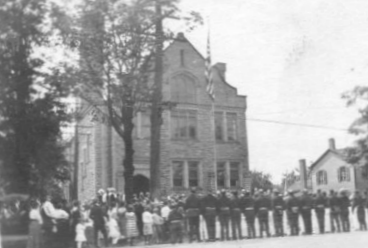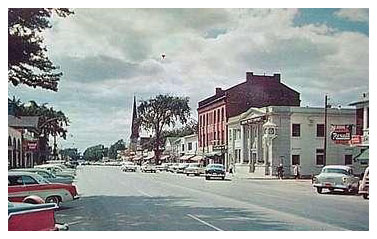Village
of Williamsville Code
Previous Chapter | Table of Contents | Next Chapter
ARTICLE V
Provisions for Flood Hazard Reduction
31-11. General standards.
In all areas of special
flood hazards, the following standards are required:
A. Anchoring.
(1) All new construction
and substantial improvements shall
be anchored to prevent flotation, collapse or lateral movement of the structure.
(2) All manufactured
homes shall be installed using methods
and practices which minimize flood damage. Manufactured homes must be elevated
and anchored to resist flotation, collapse or lateral movement Manufactured
homes shall be elevated to or above the base flood elevation or two (2)
feet above the highest adjacent grade when no base flood elevation has
been determined. Methods of anchoring may include, but are not to be limited
to, use of over-the-top or frame ties to ground anchors. This requirement
is in addition to applicable state and local anchoring requirements for
resisting wind forces.
B. Construction materials
and methods.
(1) All new construction
and substantial improvements shall
be constructed with materials and utility equipment resistant to flood
damage.
(2) All new construction
and substantial improvements shall be constructed using methods and practices
that minimize flood damage.
C. Utilities.
(1) Electrical, heating,
ventilation, plumbing, air conditioning equipment and other service facilities
shall be designed and/or located so as to prevent water from entering or
accumulating within the components during conditions of flooding. When
designed for location below the base flood elevation, a professional engineer's
or architect's certification is required.
(2) All new and replacement
water supply systems shall be designed to minimize or eliminate infiltration
of floodwaters into the system.
(3) New and replacement
sanitary sewage systems shall be designed to minimize or eliminate infiltration
of floodwaters.
(4) On-site waste disposal
systems shall be located to avoid impairment to them or contamination from
them during flooding.
D. Subdivision proposals.
(1) All subdivision prod
shall be consistent with the need to minimize flood damage.
(2) All subdivision prod
shall have public utilities and facilities, such as sewer, gas, electrical
and water systems, located and constructed to minimize flood damage.
(3) All subdivision prod
shall have adequate drainage provided to reduce exposure to flood damage.
(4) Base flood elevation
data shall be provided for subdivision prod and other proposed developments,
including proposals for manufactured home parks and subdivisions greater
than either fifty (50) lots or five (5) acres.
E. Encroachment
(1) All proposed development
in riverine situations where no flood elevation data is available (unnumbered
A Zones shall
be analyzed to determine the effects on the flood- carrying capacity of
the area of special flood hazards as set forth in § 31-10A(3). Permit
application review. This may require the submission of additional technical
data to assist in the determination.
(2) In all areas of special
flood hazard in which base flood elevation data is available pursuant to
Subsection D(4) and no floodway has been determined, the cumulative effects
of any proposed development, when combined with all other existing and
anticipated development, shall not increase the water surface elevation
of the base flood more than one (1) foot at any point. [Editor's Note:
Amended at time of adoption of Code; see Ch. 1, General Provisions, Art.
I.]
(3) In all areas of special
flood hazard where floodway data is provided or available, the requirements
of § 31-13, Floodways, shall apply. [Editor's Note: Amended at time
of adoption of Code; see Ch. 1, General Provisions, Art. I.]
§ 31-12. Specific standards.
[Editor's Note: Amended
at time of adoption of Code; see Ch. 1, General Provisions, Art. I.]
In all areas of special
flood where base flood elevation data has
been provided as set forth in § 31-4, Basis for establishing areas
of special flood hazard, the following standards are required:
A. Residential construction.
New construction and substantial improvements of any residential structure
shall:
(1) Have the lowest floor,
including basement or cellar, elevated to or above the base flood elevation.
(2) Have fully enclosed
areas below the lowest floor that are subject to flooding designed to automatically
equalize hydrostatic flood forces on exterior walls by allowing for the
entry and exit of floodwaters. Designs for meeting this requirement must
either be certified by a licensed professional engineer or architect or
meet or exceed the following minimum criteria:
(a) A minimum of two
(2) openings having a total net area of not less than one (1) square inch
for every square foot of enclosed area subject to flooding.
(b) The bottom of all
such openings shall be no higher than one (1) foot above the lowest adjacent
finished grade.
(c) Openings may be equipped
with louvers, valves, screens or other coverings or devices, provided that
they permit the automatic entry and exit of floodwaters.
B. Nonresidential construction.
New construction and substantial improvements of any commercial, industrial
or other nonresidential structure, together with attendant utility and
sanitary facilities, shall either have the lowest floor, including basement
or cellar, elevated to or above the base flood elevation or be floodproofed
so that the structure is watertight below the base flood level with walls
substantially impermeable to the of water. All structural components located
below the base flood level must be capable of resisting hydrostatic and
hydrodynamic loads and the effects of buoyancy.
(1) If the structure
is to be elevated, fully enclosed areas below the base flood elevation
shall be designed to automatically (without human intervention) allow for
the entry and exit of floodwaters for the purpose of equalizing hydrostatic
flood forces on exterior walls. Designs for meeting this requirement must
either be certified by a licensed professional engineer or a licensed architect
or meet the following criteria:
(a) A minimum of two
(2) openings having a total net area of not less than one (1) square inch
for every square foot of enclosed area subject to flooding.
(b) The bottom of all
such openings shall be no higher than one (1) foot above the lowest adjacent
finished grade.
(c) Openings may be equipped
with louvers, valves screens or other coverings or devices, provided that
they permit the automatic entry and exit of floodwaters.
(2) If the structure
is to be floodproofed:
(a) A licensed professional
engineer or architect shall develop and/or review structural design, specifications
and plans for the construction and shall certify that the design and methods
of construction are in accordance with accepted standards of practice to
me the structure watertight with walls substantially impermeable to the
passage of water, with structural components having the capability of resisting
hydrostatic and hydrodynamic loads and effects of buoyancy.
(b) A license professional
engineer or licensed land surveyor shall certify the specific elevation
(in relation to mean sea level) to which the structure is floodproofed.
C. The local administrator
shall maintain on record a copy of all such certificates noted in this
section.
D. Construction standards
for areas of special flood hazards without base flood elevations. New construction
or substantial improvements of structures, including manufactured homes,
shall have the lowest floor, including basement, elevated to or above the
base flood elevation or two (2) feet above the highest adjacent grade where
no elevation data is available.
(1) New construction
or substantial improvements of structures, including manufactured homes,
shall have the lowest floor, including basement, elevated at least two
(2) feet above the highest adjacent grade next to the proposed foundation
of the structure.
(2) Fully enclosed areas
below the lowest floor that are subject to flooding shall be designed to
automatically (without human intervention) allow for the entry and exit
of floodwaters for the purpose of equalizing hydrostatic flood forces on
exterior walls. Designs for meeting this requirement must either be certified
by a licensed professional engineer or a licensed architect or meet the
following criteria
(a) A minimum of two
(2) openings having a total net area of not less than one (1) square inch
for every square foot of enclosed area subject to flooding.
(b) The bottom of all
such openings shall be no higher than one (1) foot above the lowest adjacent
finished grade.
(c) Openings may be equipped
with louvers, valves, screens or other coverings or devices, provided that
they permit the automatic entry and exit of floodwaters.
§ 31-13. Floodways.
[Editor's Note: Amended
at time of adoption of Code; see Ch. 1, General Provisions, Art. 1.]
Located within areas
of special flood hazard are areas designated as floodways (see definition,
§ 31-2). The floodway is an extremely hazardous area due to high-velocity
floodwaters carrying debris and posing additional threats from potential
erosion forces. When floodway data is available for a particular site as
provided by § 31-4, all encroachments, including fill, new construction,
substantial improvements and other development, are prohibited within the
limits of the floodway unless a technical evaluation demonstrates that
such encroachments shall not result in any increase in flood levels during
the occurrence of the base flood discharge.
ARTICLE VI
Variance Procedure
Previous Chapter | TOP | Table of Contents | ARTICLE VI

|
A picture of 5583 Main St Village Hall pictured in 1949 was originally built with limestone mined from the Young's limestone quarry which occupied what is now The Country Club of Buffalo. click here to see a bigger picture.
|

|
A picture of Main St looking West taken in 1950. The Ronecker building on the right is now home to Marty's formal wear. Picture courtesy of Dan Crapsi. click here to see a bigger picture.
|
Click Here to see more pictures
 |
 |



